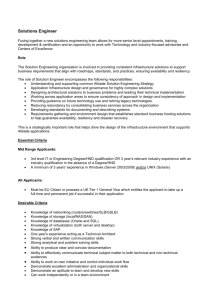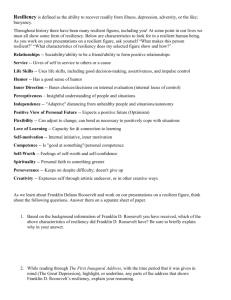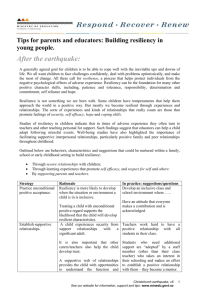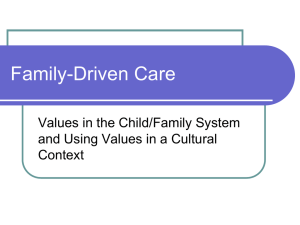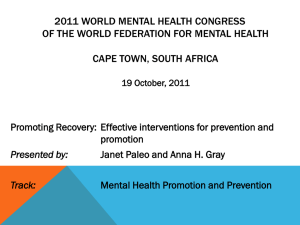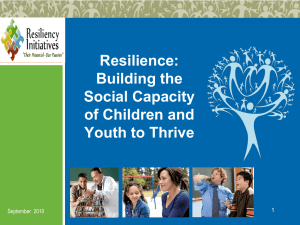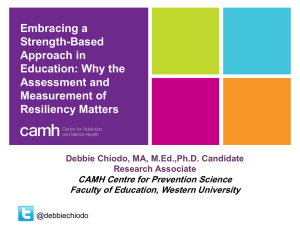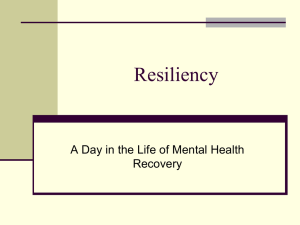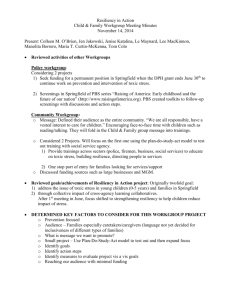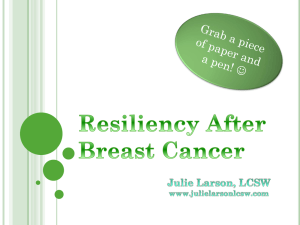A Transition/Career Planning Curriculum for Youth in the Justice
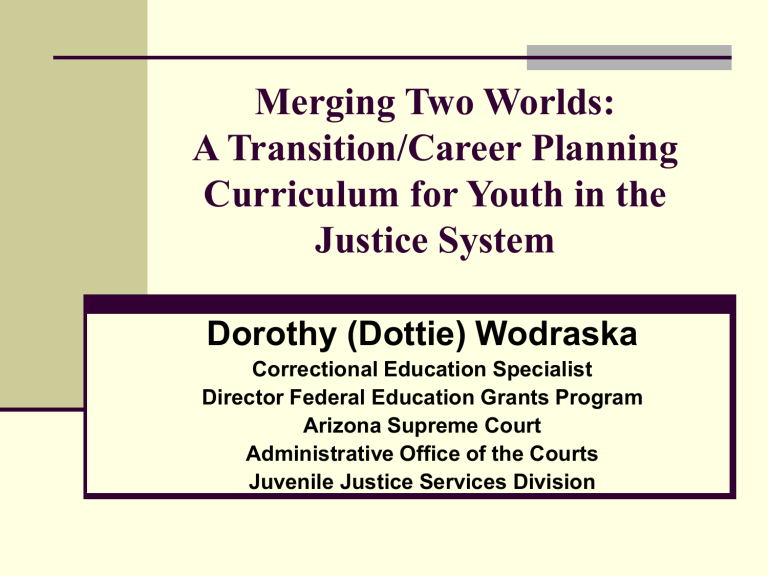
Merging Two Worlds:
A Transition/Career Planning
Curriculum for Youth in the
Justice System
Dorothy (Dottie) Wodraska
Correctional Education Specialist
Director Federal Education Grants Program
Arizona Supreme Court
Administrative Office of the Courts
Juvenile Justice Services Division
Arizona Secure Care Education
Secure Care education is defined as every education program which exists in a county detention, county jail, state juvenile corrections, and state prison facility in the
State of Arizona excluding Native American and federal facilities.
AOC 14 county juvenile detention facilities (age 8-18)
Jails 15 county jails (age 14-22)
ADJC 4 state juvenile correction facilities (age 8-18)
ADC 10 state prisons and 3 private prisons (age 14-22)
TOTAL: 46 facilities statewide
Arizona Secure Care Education
Secure Care Education must address these acknowledged needs:
1) Institutional confinement programming must prepare youth for a successful reintegration back to their community.
2) Lessons and skills learned in secure care environments must be monitored and reinforced outside of the institution.
3) Reintegration of students from the juvenile justice system requires cooperative and collaborative relationships with local school districts prior to release from a secure care facility to ensure a continuum of services and appropriate placement which can reduce recidivism.
Local Challenges… National Focus
Transient student population
Students have attended various public schools/charters and/or have dropped out of school due to lack of success.
Records exchange for prompt provision of specialized instruction if a student has a history of special education.
Multi-jurisdictional issues prompted by legislatively-mandated structure
Conflicting organizational philosophies within agencies between security (punitive) and education (rehabilitative).
Reintegration: lack of cooperative and collaborative relationship with the local school districts prior to release from a secure care facility to ensure continuum of services and appropriate placement which can reduce recidivism.
Shortage of adequately trained personnel in the area of correctional education.
Secure Care Education Committee
(SCEC)
Mission
To advocate for excellence in secure care education which leads to student centered seamless reintegration from correctional facilities into community settings in order to reduce recidivism.
History
The SCEC was formed in 1998 by staff of the Arizona Department of
Education and secure care educators from across the state to address the glaring educational needs of youth and adults in correctional settings.
Accomplishments
The SCEC has developed the Merging Two Worlds (MTW) Curriculum through a ADE grant-supported partnership with the Pima County School
Superintendent’s Office, Special Programs Division. www.ade.az.gov/ess/securecare
Since 1999 the SCEC has hosted four statewide conferences for training educators on implementation of the MTW, developed a statewide regional structure for ongoing training, mentoring and technical assistance and standardized special ed reporting forms to facilitate electronic transfer of records.
Merging Two Worlds Curriculum
(MTW)
A Transition/Career Planning Curriculum
Prepares Students for reintegration into the community, school or world of work upon release from a secure care environment
Emphasizes the interconnection between the “worlds” of secure care and the community
Instruction in life skills, career development skills, resiliency and social skills which meet Arizona Academic
Standards
Based on Resiliency Skills Research
What Is Resiliency?
Resiliency is the ability to spring back from and successfully adapt to adversity.
“Bouncing back from problems and stuff with more power and more smarts.” (
Student, Age 15)
Research from psychology, psychiatry and sociology conclude that individuals have an innate capacity for resiliency, “a self-righting tendency”
Resiliency-building conditions are needed
(Source: Resiliency In Action, Inc. 2004)
Resiliency Building Skills:
Conditions and Attitude
Conditions for Resiliency:
Caring and Support
High Expectations for
Success
Opportunities for
Meaningful Participation
Positive Bonds
Clear and Consistent
Boundaries
Life Skills
Resiliency Building Skills:
Conditions and Attitude Cont’d.
“Resiliency Attitude” – “What is right with you is more powerful than anything that is wrong with you.”
Focus on personal strengths more than problems and weaknesses.
Provide the conditions for building resiliency for self and others.
Have patience…..successfully bouncing back from trauma and/or crisis takes time.
(Source: www.resiliency.com)
MTW Curriculum Focus:
Resiliency Building Skills
Sense of Purpose
Inner direction
Bases choices on internal evaluation
Internal focus of control
View of future
Optimistic
Spirituality
Personal faith in something greater
Perseverance
Doesn’t give up despite obstacles
Resiliency Building Skills (cont’d)
Social Competence
Relationships
Able to form & build relationships
Able to be a friend, and keep close
Humor
Can see the “funny”
Perceptive
Insightful understanding of people and situations
Assertive
Clearly expresses opinions, feelings, ideas
Understands how attitude influences others
Resiliency Building Skills (cont’d)
Problem Solving
Flexibility
Can adjust to change
Can adapt to cope
Love of Learning
Needs to know
Loves to find out
Creativity
Sees unique choices, consequences
Individualistic
Goal Setting
Knows power of goals
Decision Making
Uses process and can explain
Resiliency Building Skills (cont’d)
Autonomy
Independence
Health/wellness
Adaptive distancing from unhealthy people and situations
Self motivation
Inner passion and direction
Competence
Is “good at something”
Has skills to manage life
Self worth
Feeling self confident
MTW Curriculum Organization
Pre-Assessment Tools: Structured Interview; Individual
Learning Plan; Student Screening Report for Child Find; Credit
Information and Certificate; Educational History
Four Chapters with 10 Lessons in each Chapter:
Teacher Resources: Work Evaluation Rubric & Lesson
Resources
Chapter 1: Transition Planning: Who Am I?
Chapter 2: Career Preparation: Where Am I Going?
Chapter 3: Transition Planning: How Do I Get There?
Chapter 4: Life Planning: How Do I Keep It All Together?
My Resource Guide (MRG), Personal Transition
Survival Guide: Merge Checklist; Certificate of
Competency; Chapter Reflection Sheet
MTW Chapter Organization
Acknowledgement
Facilitation Tips
Chapter Background
Overview of Chapter Contents & Format
Table of Contents
Work Evaluation Rubric Aligned with Arizona
State Standards
Lesson Theme, Objective & Steps to Follow
Materials Needed: Handouts etc.
Evaluation Rubric
Enrichment
Chapter 1 - Transition Planning:
Who Am I?
Concept of Resiliency as Critical to Successful
Reintegration
Self-Awareness Strengthens Resiliency –
“Bouncing Back”
Lesson Topics Include: Value, Beliefs, Self
Confidence, Learning Styles & Interests, Personal
Skills, Job/Career Paths, Decision Making
Career Planning as a Dynamic Process
Employment Trends: Impact of Technology,
Globalization, New Economy
Managing Change through “Process and Self-
Awareness”
Building My Resource Guide (MRG) – A Personal
Transition Survival Guide
Chapter 2 - Career Preparation:
Where Am I Going?
All lessons include self talk, self-awareness, stop and think, resiliency, decision making and planning
Each lesson concludes with the Self-Talk litany
Lesson Topics Include: Make a Decision, Values,
The Power of Goals, Priorities, Lifestyle, Choices and Consequences, Gathering
Information/Observe, Gathering Information/Ask
Questions, Gathering Information/Listen, Other
Points of View, Make a Decision
Building My Resource Guide (MRG)
Chapter 3 - Transition Planning:
How Do I Get There?
Concept of Self-Assessment leading to Self-
Awareness
Life Through a Wide-Angle Lens and Other Points of
View
Lesson Topics Include: Self talk, Self Awareness,
Decision Making, Social Skills, Planning
Resiliency: Successfully Bouncing Back from
Adversity
Planning Process: Goal Setting
Nine Life Areas: Leisure, Spiritual, Health/Wellness,
Learning, Career, Financial, Family Relationships,
Community
Social Skills Practice
Building My Resource Guide (MRG)
Chapter 4 - Life Planning:
How Do I Keep It All Together?
Continues concept of self assessment as selfawareness through emphasizing community resources
Lesson Topics Include: Transition into the
Community, Self Talk, Self Awareness, Stop and
Think, Resiliency, Decision Making, and Planning
Lessons include: Finding a Place to Live, Money
Management, Food, Medical Treatment, transportation, Communication, Employment,
Education, Leisure Time, Support
Continues development of MRG (My Resource
Guide)
MTW Impact &
Feedback From The Field
Curriculum well-structured and flexible
40 Lessons difficult to implement in short-term facilities: Adapt Curriculum accordingly (Mini
Version)
Coordinate evaluation and assessment of impact on students while in the facilities and impact on recidivism
Provide Pre-service and In-service training for correctional educators on implementing and adapting the curriculum
Mini Merging Two Worlds
(Mini M2W)
Adaptation developed through a 2-yr. Grant from the Arizona Department of Education/Exceptional
Student Services (ADE/ESS)
Promoted through a collaboration of ADE/ESS;
ASU; ADJC; Pima County Schools; SCEC
4 Chapters, 12 Lessons centered on skills for transition to provide student-centered portfolio
Data collected through student and teacher surveys and reported to the ADE
Curriculum aligned with Arizona State Standards
Merging Two Worlds/
Corrections Learning Network (CLN)
Project
Arizona Detention Schools collaborating with CLN to convert M2W
Curriculum for nationwide broadcast through CLN network
Resource for 800 correctional sites currently receiving CLN programming
CLN is a nationally recognized distance learning initiative funded through U.S.
Dept. of Education, administered by
ESD 101 in Spokane, WA
Curriculum available through ADE website http://www.ade.az.gov/ess/securecare/
Closing Thoughts…
Children are always the only future the human race has; Teach them well.
Research indicates that education and workplace preparation are the two most fundamental factors in reducing recidivism by assisting ex-offenders to obtain and retain employment and return to a law-abiding lifestyle.
Contact Information
Dorothy (Dottie) Wodraska,
Correctional Education Specialist
Director, Federal Education Grants Program
Arizona Supreme Court,
Administrative Office of the Courts (AOC)
Juvenile Justice Services Division
1501 West Washington, Suite 337
Phoenix, AZ 85007
Phone: (602) 542-9573
Fax: (602) 542-9479
Email:
DWodrask@supreme.sp.state.az.us
ADE/ESS Website: http://www.ade.az.gov/ess/secure care
